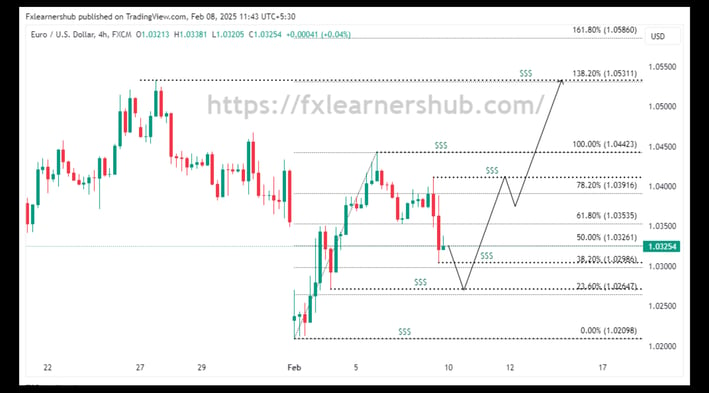EURUSD Weekly Analysis 02/08/2025
Satheesh Gobi
2/8/2025


Fundamental analysis
1. Overview of Momentum and Market Structure
Current Momentum: Bullish.
Previous Week's Performance: Bullish.
Range: 1.0210 – 1.0442
Expectations: Anticipating a bullish continuation within the range, targeting new highs.
Trading Plan
Bearish Bias
Strategy:
Watch for price action rejections at the following resistance zones:1.0442(Extreme Liquidity)
1.0531 Extension
Targets:
Primary target: 1.0304 (H4 Liquidity) and 1.0271 (H4 Liquidity).
Secondary target: 1.210 (Extreme Liquidity)
For Long
Strategy:
Monitor price action at the following support levels for potential reversals:1.0304 (H4 Liquidity)
1.0271 (H4 Liquidity)
Confirmation:
Look for reversal patterns such as bullish engulfing candles or order block formations before entering long positions.Targets:
Primary Target: 1.0410 (H4 Liquidity) and 1.0442 (Extreme Liquidity).
Extended Target: 1.0531 and 1.0586 (Extensions).
Summary
The bias remains bullish within the 1.0210 – 1.0442 range.
Long entries are favorable around support levels (1.0304, 1.0271) with confirmation.
Short opportunities may arise near or above 1.0440/1.0531 if signs of exhaustion emerge.
Use your strict money management rules to manage risks effectively.
Technical analysis
The EUR/USD pair dropped to near 1.0360 after the release of the January U.S. Nonfarm Payrolls (NFP) data. The NFP report showed a slower-than-expected 143,000 new jobs, but a surprising acceleration in wage growth (4.1% year-on-year) added pressure on the Euro. The U.S. Dollar strengthened, pushing the Dollar Index (DXY) near 107.90.
While the NFP report’s modest labor data signals possible Fed rate cuts in June, market uncertainty remains as Fed Chair Jerome Powell suggested monetary adjustments would depend on inflation progress or labor market weakness.
In the Eurozone, concerns about U.S. tariffs on European goods are growing. ECB official Piero Cipollone warned that such tariffs, particularly on China, could be deflationary for the Eurozone, amplifying economic challenges. Analysts also foresee increased risks if U.S. tariffs target Europe more directly, fueling trade tensions and weighing further on the Euro.
With the ECB maintaining a dovish outlook and U.S. rates potentially holding steady, EUR/USD remains under pressure as traders eye tariff developments and economic data.








